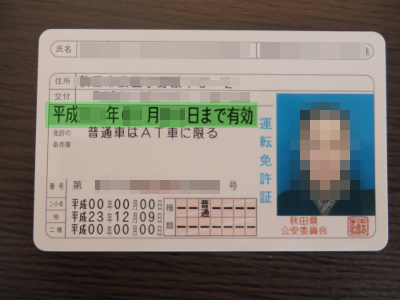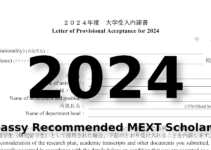Converting to a Japanese Driver’s License: The Driving Test
1. Introduction
2. Required Documents
3. Day 1: Written Test
4. Day 2: Driving Test
5. Final Paperwork
6. Renewing your License (Coming Soon)
This is the big one and where most people fail and have to re-pay and retake their test. But before we get in to the details of how you’re going to pass on the first time around,
Important note for the vain: Your driver’s license photo will be taken onsite after the test (if you pass). If you are concerned about your license photo, choose your clothes accordingly and bring whatever it is you’ll need to “freshen up” after the stress of the test itself. If you’re like me and always manage to test or renew your license on stormy, winter days, well, good luck to you on the photo department. You can’t do much worse than I have.
Arriving at the Testing Center
Unlike the Written Test day, you will want to be early for this one. As I mentioned in the last step, you should have the opportunity to walk the course for about an hour before the registration works, and you’ll want to take advantage of this to reinforce your knowledge of the course and think about where you will begin all of your maneuvers (more on that below).
Kyoto Test Takers
None of the early morning buses stop at the License Center, so you will need to get out at Hizume-guchi. Make sure you have all of your identification paperwork, your application package, and a nice long book to keep you company. I highly recommend packing your own lunch, as well. No licenses are issued before the center takes its lunch break, so unless you fail, you will be here until at least 1:30 – 1:45 pm. If you fail, you do get to go home early, but that’s hardly a consolation.
Everyone Else Start Reading Again: Walking the Course
When you completed the written test, the testing center should have given you a set of times that show when you can walk the course. Once you’re in that time window, it’s OK to go out there. In my experience, there was no announcement saying that it was OK and nobody else went out there (almost all of the other test-takers that day were from a driving school that had specifically practiced at that testing facility). Take the turn map that they gave you and walk it at least twice. Think about landmarks for turning on your blinkers, where you’re going to speed up or slow down, and practice any other cues that you’ve created for yourself.
Signing In and Paying
Usually, the payment window opens before the test registration window. Pay your ¥1650 fee to “rent” the car (a decommissioned taxi) for the test. My advice is do not be the first foreign tester in line to register, if you can help it. Of course, if everyone else has read this post, you may be hosed. If you are second, third, etc., you will ride in the back seat during the test that precedes you. You can get some free last minute advice this way, as well as a gauge on the personality and attitude of your tester. On my second attempt, I was the second driver, so I got to see at exactly what point the tester took points off (any time the pencil touches the clipboard, that’s a loss of points). Of course, the first tester managed to drive up on the sidewalk (automatic fail) twice within the first few curves, so I didn’t get to observe much, but I did at least get a perspective on how surly the tester was that morning (very).
Step-by-Step Recap of the Driving Test
The Driving Test is scored on a 100 point system with 70 as the minimum passing score. You begin with the full 100 points and lose 5 or so points for each violation. It could be more depending on the mood of the tester- they don’t actually tell you your score or provide a detailed report if you don’t pass, so it’s pretty arbitrary. There are also auto-fail criteria, such as running over the curb, which is a hazard for some on the L- and S-curves.
The most important thing about the scoring is to ignore it while you’re driving. I wrote above that when pencil touches clipboard, that’s a loss of points, but you don’t know how many points or how close you are to the threshold, so just focus on your driving and don’t get distracted. As you know by now, you’ll have enough to worry about with all the maneuvers ahead. Here is my recap of each of the turns and test points.
However, I should stress that this list is no replacement for getting a lesson from someone who knows your testing environment and the local preferences.
If I haven’t said it enough times already, here it is once again: The Driver’s Test is nothing like actual driving, and certainly nothing like the way you see most Japanese people drive. Do not behave as if you are on the road. Behave as if you are a cheesy actor in a government-produced safety instructional video: emphasize your actions and take every safety step, even if it seems ridiculous and unnecessary in your situation. That means adjusting seats and mirrors that don’t need it (adjust the back to their starting point), using daytime running lights, and taking your time before pulling away from the curve.
- Before getting in the car: Check under all sides of the car to make sure there are no obstructions or small children. When you walk past the car, make sure that you check the road as if you were walking into traffic (you may be actually walking into jittery-tester-traffic if there are other tests going on simultaneously). When you open the door to enter the car, continue to act as if traffic is present- i.e. do not throw it wide open.
- Take your seat: Sit down and adjust the position of the driver’s seat, even if it doesn’t need it (yes, seriously), then fasten your seatbelt. Adjust the position of the center rearview mirror, even if it doesn’t need it, and visibly check the position of your side-views. You will be driving a decommissioned taxi, which will seem large if you’re used to Japanese 軽自動車 and small if you’re used to full-size sedans or larger. The controls may be different from the car you’re used to driving, too. The [automatic] taxis have a central shifter, so if you’re used to it being on the column, you’ll probably hit the windshield wipers when you really want the blinkers (unless, of course, you took a lesson).
- Start Your Engine: Foot on the break, turn the ignition, turn on daytime running lights, shift into drive, then release the E-brake. Before you start moving, turn on your right turn signal and perform a complete check of your surroundings: Back right (head turn), back left (head turn), left side-view mirror, central rearview, windshield, right side-view mirror, back right (head turn) again. Then go! This is the last time you will have to execute the seven-point head swivel.
- Initial Rotation: Leave the staging area and turn right, into the leftmost lane. Shift into the right lane by following the turning procedure below, then follow the same turning procedure to turn back into the course-side of the staging area. Proceed slowly through the staging area, then merge into the course.
- Speed: Drive as you would on a regular road. I read one guide that recommended idling through the entire test, except during the mandatory 50km/h stretch. In Kyoto, at least, you can be marked down/ fail for maintaining a “dangerously slow speed.” Obviously, keep a safe speed. Slow before turns, accelerate on straight-aways where practicable, and creep through the L- and S-curves, and staging area.
- Braking: If you are one of those people who prefers to manage your speed entirely through the gas pedal, without touching the brake- don’t do that for this test. There is no need to give anyone whiplash, contrary to what I read on another guide and, of course, you don’t want to take any turns on two wheels, but braking “normally” is just fine.
- Train Crossing: Come to a complete stop before your bumper reaches the line. Roll down the window and cup your hand behind your ear to listen for the train. Look both directions down the “track,” then roll up the window and proceed.
- Disabled Vehicle: Shift into the right lane to go around the disabled vehicle, following the procedures below. As soon as you shift lanes, signal for your shift back into the left lane. You should slow down for this procedure, so take the preceding curve a little more slowly than usual.
- Turns and Lane Changes: There are several looked-for steps to your turn procedure. Each missed or late step will get you marked down. Conceivably, if you start your initial check late (-5), your signal will then be late (-5), your visual check will be late (-5), and your intra-lane positioning will be late (-5 and an extra -5 if you started moving the wheel before your head was fully forward). If you need to change lanes then turn, it is possible to lose 50 points in one go. Better luck next time.
Here’s my recommended procedure:- Roughly 60 m/200 ft from the turn point, assuming no lane change, visibly check your center rear-view and turning-side side-view mirrors,
- Signal your turn,
- Turn your head to check your blind spot on the side towards which you will be turning. Make sure your head is pointing forward again before proceeding!
- Three seconds must have passed since you turned on the turn signal, and you must be at least 30 m/100 ft away from the intersection: then move your car to the side of the lane towards which you will turn. This helps you block cyclists and motorcycles from trying to pass on the inside of your turn. It also helps you pass the test.
- Make your turn. If you are turning right and there is a diamond or triangle in the middle of the intersection, be sure to turn inside of it.
- If you are turning into a multi-lane road, you must turn into the left-most lane (unless you are about to make an immediate right turn.)
- If you are turning left, you should never be more than 50 cm/20 in from the curb.
Practice repeating the mantra “rear-view-sig-nal-swi-vel-front” to yourself over a three-second interval, if you need help timing the first three steps. Your head must be seen to turn slightly towards the mirrors as you check them, but being too dramatic can make you look unsafe and lose you points.
- Accelerate: You need to hit 50 km/h before the curve ahead. Let the car decelerate as you approach the curve, then shift into the right lane more or less as soon as you come out of the turn, following the procedures above.
- Right Turn: Immediately after the lane switch, repeat the turning procedures and turn into the left-most lane. It is not necessary to come to a full stop for this turn, but you should visibly check for oncoming traffic or traffic emerging from the cross street.
- Stoplight: Shift into the right lane (procedures), then execute your turning procedures. You may or may not have to stop at the light, depending on the timing. If you do stop, make sure to check both ways after the light goes green, because Japanese drivers love running red lights. Make your right turn on the inside of the diamond painted in the middle of the intersection and turn into the right lane. Yes, right lane, this time. You have an immediate turn coming.
- Right Turn: It is not necessary to stop before this turn, but you should proceed very slowly and check both ways before reaching the intersection. Turn into the left-most lane.
- Intersections:Now is a good time to mention that there are four kinds of intersections on this course, not counting the stoplight as a separate class:
- Right of Way- You have obvious right of way (you’re on the wider road). There is no need to stop or slow down, but looking both ways is briefly is good.
- Stop sign- Come to a full stop before the line, then check left and right and proceed.
- Visual Obstruction (hedge)- Slow down to a crawl, get as far forward of the obstruction as possible, to enable a visual check, without entering the intersection. Where there is both a stop sign and a visual obstruction, you will have to go through the stop sign procedure in its entirety then the visual obstruction procedure in its entirety.
- All others- No stop sign, no visual obstruction. Slow way down and check both ways before entering the intersection. No need to stop, even if the other road looks bigger. Unless there’s oncoming traffic, of course.
- L-Curves: Shift into the right lane, then turn right into the last L-curve. Proceed at a crawl through the L-curve. Do not run over the curb! This is an auto-fail. If you feel the curb, you are permitted to back up once and try again, as long as you haven’t ridden up on it yet. Stop before you reach the intersection at the end of the curve and signal a right turn.
- Quick Right Turn: You will be on a narrow road, with no lane markings. There is no need to move your car to the right before executing the turn. The sign here indicates you have the right of way.
- Left Turn (Stop, Visual Obstruction): Left turn procedures, make sure you slide the car to the left to block bikers. Come to a full stop for the stop sign, creep forward to see around the hedge, then make your left turn. Your vehicle should stay within 50 cm/20 in of the curb at all times- no wide turns!
- S-Curve: Left turn procedures. Stay within 50 cm/ 20 in of the curb even though you are making a hairpin turn into the S-curve. It’s really tempting to go wide here, but don’t do it. Your taxi can make this turn. Emerging from the curve, you will stop, go left and immediately right. There’s no time for proper turn procedures here, so just make it work.
- Left Turn (Visual Obstruction): Before reaching this turn, you will go through an ambiguous intersection. Slow down and check both ways before entering the intersection. Left turn, as above, into the left lane, then shift to the right lane.
- Right Turn: Turn right into the left-most lane. It seems to be ok to run over the triangle painted in the middle of the intersection here. You do not need to stop for the railroad crossing (it does not cross your lanes). Execute a left turn (follow procedures) into the parking side of the staging area and park where directed. You are not done yet!
- Exit the Vehicle: Activate the E-brake, then shift into park. You may be instructed to leave the car running. Release your seatbelt. Check your rearview, then driver’s side mirror. Turn your head to check your blind spot. Open the door just wide enough to see out. Check visibly again, then open your door just wide enough to get out, as if you were exiting into traffic, exit the vehicle, close the door, and proceed around the front of the vehicle to the passenger side to talk to the tester. It is still entirely possible to go from passing to failing at this point in the test.
If you failed the test, you will need to pay the ¥2400 plus 1650 when you retake. Depending on the lesson places near you, failure probably costs more than a lesson!





